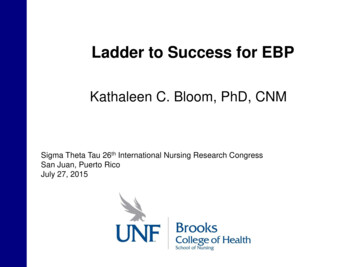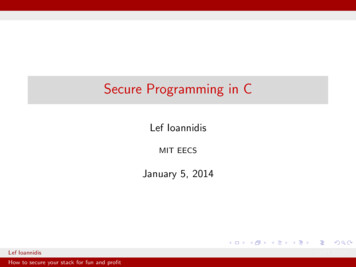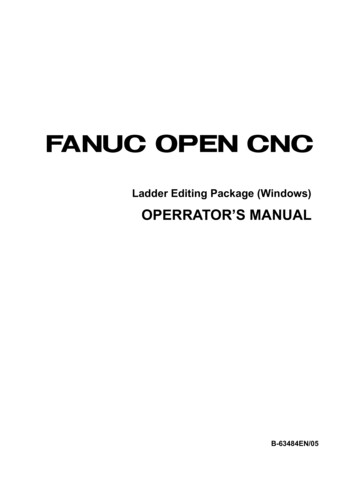
Transcription
Ladder to Success for EBPKathaleen C. Bloom, PhD, CNMSigma Theta Tau 26th International Nursing Research CongressSan Juan, Puerto RicoJuly 27, 2015
Brooks College of HealthSchool of Nursing: Prior to Fall 2014 Bachelor of Science in Nursing Regular Prelicensure Accelerated Prelicensure RN to BSN Master of Science in Nursing Clinical Nurse Specialist Nurse Anesthesia Primary Care Nurse Practitioner Post-master’s Certificate Post-master’s Doctor of Nursing Practice
The UNF Ladder to Success inEvidence-based PracticeDNP ProjectEvidence-based Practice IIEvidence-based Practice IDNPProgramStatistical InterpretationEpidemiologyThesis/ProjectResearch Methods for EBPMSNProgramNursing Science IIINursing Science IINursing Science IBSNProgram
Brooks College of HealthSchool of Nursing: Beginning Fall 2014 Bachelor of Science in Nursing Regular Prelicensure Accelerated Prelicensure RN to BSN Master of Science in Nursing Clinical Nurse Specialist Doctor of Nursing Practice Family Nurse Practitioner Nurse Anesthesia Post-master’s With new certification Without new certification
UNF Ladder to Success inEvidence-based Practice DNP ProjectRevisedEvidence-based Practice IIEvidence-based Practice IStatistical InterpretationDNPProgramEpidemiologyResearch Methods for EBPNursing Science IIINursing Science IINursing Science IBSNProgram
Steps in the EBP Process Cultivate a spirit of inquiryFormulate an answerable questionSystematic search for evidenceCritically appraise the evidenceIntegrate evidence with clinician’s expertise andpatient’s desires and wishes Implement EBP decision Evaluate results Disseminate results
How It WorksBSN
ProjectEvidence-based Practice IIEvidence-based Practice IDNPProgramStatistical InterpretationEpidemiologyThesis/ProjectResearch Methods for EBPMSNProgramNursing Science III: Decision-making with EBPNursing Science II: Understanding the EvidenceNursing Science I: Finding the EvidenceBSNProgram
EBP Steps Cultivate a spirit of inquiryFormulate an answerable questionSystematic search for evidenceCritically appraise the evidenceIntegrate evidence with clinician’sexpertise and patient’s desiresand wishes Implement EBP decision Evaluate results Disseminate resultsNS I Outcomes Describe the purpose and theprocess involved in conductingand writing a comprehensivereview of the literature. Differentiate among various typesof literature. Use a variety of resources inlocating scientific and otherliterature. Select a PICOT question from alist provided. Conduct a literature search to findrelevant research and theoreticalinformation related to the PICOTquestion chosen.
EBP Steps Cultivate a spirit of inquiryFormulate an answerable questionSystematic search for evidenceCritically appraise the evidenceIntegrate evidence with clinician’sexpertise and patient’s desiresand wishes Implement EBP decision Evaluate results Disseminate resultsNS II Outcomes Recognize sources of scientificnursing literature for strength ofresearch evidence according to arating system Distinguish between steps in theresearch and the evidence-basedpractice processes. Critically appraise primaryqualitative and quantitativeresearch reports for quality andpractice implications in the contextof evidence-based practice.
EBP Steps Cultivate a spirit of inquiryFormulate an answerable questionSystematic search for evidenceCritically appraise the evidenceIntegrate evidence with clinician’sexpertise and patient’s desiresand wishes Implement EBP decision Evaluate results Disseminate resultsNS III Outcomes Discuss the application ofevidence-based models as a basisfor planned change. Critically appraise systematicreviews for quality and practiceimplications in the context ofevidence-based practice. Critically appraise guidelines forquality and practice implications inthe context of evidence-basedpractice. Analyze factors that inhibit andfacilitate evidence-based nursingpractice.
How It WorksMSN
ProjectEvidence-based Practice IIEvidence-based Practice IDNPProgramStatistical InterpretationEpidemiologyThesis/Project: Synthesizing EvidenceResearch Methods for EBP: Appraising EvidenceMSNProgramNursing Science III: Decision-making with EBPNursing Science II: Understanding the EvidenceNursing Science I: Finding the EvidenceBSNProgram
EBP Steps Cultivate a spirit of inquiryFormulate an answerable questionSystematic search for evidenceCritically appraise the evidenceIntegrate evidence with clinician’sexpertise and patient’s desiresand wishes Implement EBP decision Evaluate results Disseminate resultsResearch MethodsOutcomes Formulate a clinical questionrelevant to advanced nursingpractice. Access relevant research studies,research syntheses and evidencebased clinical practice guidelines. Analyze research methods. Critically appraise researchstudies, research syntheses andevidence-based clinical practiceguidelines. Design a research synthesis orstudy relevant to advancednursing practice
EBP Steps Cultivate a spirit of inquiryFormulate an answerable questionSystematic search for evidenceCritically appraise the evidenceIntegrate evidence with clinician’sexpertise and patient’s desiresand wishes Implement EBP decision Evaluate results Disseminate resultsThesis ProjectOutcomes Synthesize current researchrelating to selected topic anddetermine a specific problem to beexplored. Complete a research synthesisOR Complete a research study
How It WorksDNP
Project: CapstoneEBP II: DisseminationEBP I: Proposal for EBP ChangeDNPProgramStatistical Interpretation: Using StatsEpidemiology: Understanding EpiThesis/ProjectResearch Methods for EBPMSNProgramNursing Science IIINursing Science IINursing Science IBSNProgram
EBP Steps Cultivate a spirit of inquiryFormulate an answerable questionSystematic search for evidenceCritically appraise the evidenceIntegrate evidence with clinician’sexpertise and patient’s desiresand wishes Implement EBP decision Evaluate results Disseminate resultsEpidemiologyOutcomes Analyze the epidemiology ofvarious infectious and chronicconditions Discuss current trends in theprevalence rates for variousinfectious and chronic conditions. Discuss morbidity and mortalityand the behaviors associated withinfectious and chronic conditions.
EBP Steps Cultivate a spirit of inquiryFormulate an answerable questionSystematic search for evidenceCritically appraise the evidenceIntegrate evidence with clinician’sexpertise and patient’s desiresand wishes Implement EBP decision Evaluate results Disseminate resultsStatistics Outcomes Identify which statistical methodsare appropriate for a given dataset Evaluate the effectiveness ofstatistical support claims in healthpublications Employ statistical methods thatwill support strength claims forevidence Recognize standard researchdesigns and be aware of thestrengths and weaknesses ofeach of the designs presented.
EBP Steps Cultivate a spirit of inquiryFormulate an answerable questionSystematic search for evidenceCritically appraise the evidenceIntegrate evidence with clinician’sexpertise and patient’s desiresand wishes Implement EBP decision Evaluate results Disseminate resultsEBP I Outcomes Identify nursing practice issue foranalysis Critically analyze applicable databy integrating primary researchsources and existing reviews ofscientific literature. Use systematic search strategiesto prepare a critical appraisal tableof the evidence to address theidentified issue. Develop a proposal for anevidence-based practice change.
EBP Steps Cultivate a spirit of inquiryFormulate an answerable questionSystematic search for evidenceCritically appraise the evidenceIntegrate evidence with clinician’sexpertise and patient’s desiresand wishes Implement EBP decision Evaluate results Disseminate resultsEBP II Outcomes Identify a focus for an evidencebased practice question Evaluate existing practiceguidelines and resourcesnecessary to support an evidencebased change in a practicesetting. Prepare a strategic plan toimplement and evaluate anevidence-based practice changeincluding strategies fordissemination of evidence to guidebest practice.
EBP Steps Cultivate a spirit of inquiryFormulate an answerable questionSystematic search for evidenceCritically appraise the evidenceIntegrate evidence with clinician’sexpertise and patient’s desiresand wishes Implement EBP decision Evaluate results Disseminate resultsProject Outcomes Implement an evidence-basedpractice change. Evaluate the outcomes related tothe change. Disseminate the results!
Program Outcomes Graduates of BSN, MSN and DNPPrograms on research councils at theirplaces of employment Multiple local, regional and nationalpresentations of evidence-based practiceprojects Multiple publications related to evidencebased practice
The UNF Ladder to Success in Evidence-based Practice DNP Project DNP Program Evidence-based Practice II Evidence-based Practice I Statistical Interpretation Epidemiology Thesis/Project MSN Research Methods for EBP Program Nursing Science III BSN Program Nursing Science II Nursing Science I










